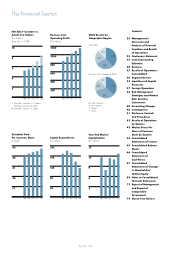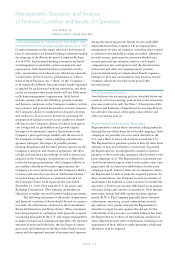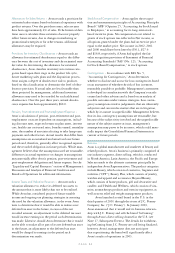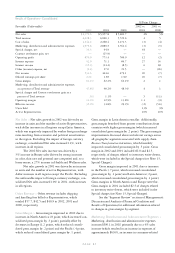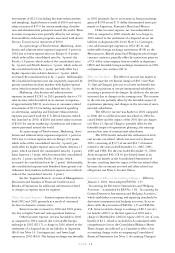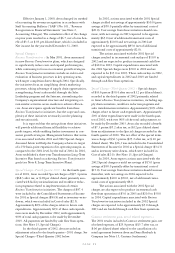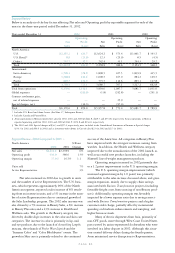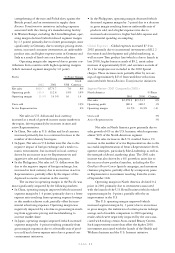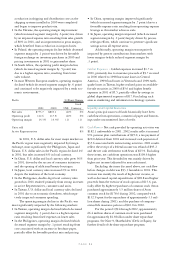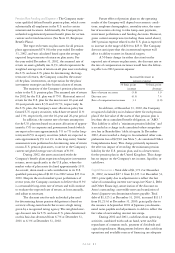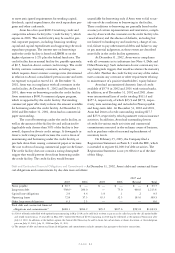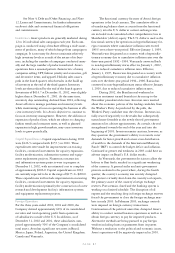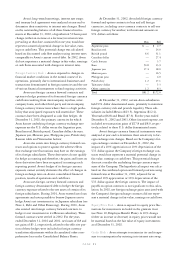Avon 2001 Annual Report Download - page 5
Download and view the complete annual report
Please find page 5 of the 2001 Avon annual report below. You can navigate through the pages in the report by either clicking on the pages listed below, or by using the keyword search tool below to find specific information within the annual report.PAGE 28
investments of $22.0 (including brochure enhancements
and sampling), higher bonus accruals of $16.0 and merit
salary increases of $15.0 for certain marketing, distribu-
tion and administrative personnel around the world. These
increases in expenses were partially offset by net savings
from workforce reduction programs associated with Avon’s
Business Transformation initiatives of $30.0.
As a percentage of Total revenue, Marketing, distri-
bution and administrative expenses improved .4 point in
2002 due to lower expense ratios in Europe (1.9 points,
which reduced the consolidated ratio by .4 point), the
Pacific (1.9 points, which reduced the consolidated ratio
by .3 point) and North America (.3 point, which reduced
the consolidated ratio by .1 point), partially offset by a
higher expense ratio in Latin America (.3 point, which
increased the consolidated ratio by .1 point). Additionally,
the consolidated expense ratio was negatively impacted by
greater contributions from markets with higher expense
ratios (which increased the consolidated ratio by .3 point).
Marketing, distribution and administrative
expenses increased $128.1 in 2001 primarily due to a 5%
sales increase (which resulted in an increase in expenses
of approximately $82.0), an increase in consumer-related
investments of $32.0 (including incremental spending
on advertising, sampling and brochure enhancements),
expenses associated with the U.S. Retail business (which
was launched in 2001) of $20.0 and merit salary increases
of $16.0 for certain marketing, distribution and adminis-
trative personnel around the world.
As a percentage of Total revenue, Marketing, distri-
bution and administrative expenses improved .1 point in
2001 due to a lower expense ratio in Europe (2.0 points,
which reduced the consolidated ratio by .4 point), par-
tially offset by higher expense ratios in North America (.5
point, which increased the consolidated ratio by .2 point),
Latin America (.3 point, which increased the consolidated
ratio by .1 point), and the Pacific (.8 point, which
increased the consolidated ratio by .1 point). Additionally,
the consolidated expense ratio benefited from greater con-
tributions from markets with lower expense ratios (which
reduced the consolidated ratio by .1 point).
See the “Segment Review” sections of Management’s
Discussion and Analysis of Financial Condition and
Results of Operations for additional information related
to changes in expense ratios by segment.
Other (Income) Expense > Interest expense decreased in
both 2002 and 2001 primarily as a result of continued
declines in domestic interest rates.
Interest income increased in 2002 and 2001 prima-
rily due to higher Cash and cash equivalent balances.
Other (income) expense, net was favorable in 2002
as compared to 2001, mainly due to favorable foreign
exchange in 2002 ($23.7), a charge in 2001 related to the
settlement of a disputed excise tax liability in Argentina
($6.4) (see Note 14, Contingencies), and lower legal
expenses in 2002 ($4.6). Net foreign exchange was favorable
in 2002 primarily due to an increase in foreign exchange
gains of $19.8 on net U.S. dollar denominated assets pri-
marily in Argentina, Venezuela, Brazil and Mexico.
Other (income) expense, net was unfavorable in
2001 as compared to 2000, mainly due to a charge in
2001 related to the settlement of a disputed excise tax
liability in Argentina ($6.4) (see Note 14, Contingen-
cies), additional legal expenses in 2001 ($5.4), and
unfavorable foreign exchange movements ($3.8) on the
Mexican peso, British pound and Philippine peso foreign
currency contracts, partially offset by transaction gains on
a U.S. dollar intercompany loan receivable in Argentina
($8.0) and favorable foreign exchange movements in 2001
on Japanese yen contracts ($2.4).
Effective Tax Rate > The effective tax rate was higher in
2002 because the net Special charges of $36.3 (see Note
13, Special Charges) gave rise to a lower tax benefit due
to the loss positions of certain international subsidiaries
incurring a portion of the charges. In addition, the tax rate
increased due to changes in the earnings mix. The increase
in the rate was partially offset by the favorable impact of
repatriation planning and changes in the tax rates of inter-
national subsidiaries.
The effective tax rate was higher in 2001 compared
to 2000 due to a federal income tax refund in 2000 dis-
cussed below and the impact of the 2001 Special charges
(see Note 13, Special Charges), partially offset by the
favorable impact of repatriation planning, the earnings
mix and tax rates of international subsidiaries.
The 2000 results included the settlement of a fed-
eral income tax refund, which was received in January
2001, consisting of $32.5 of tax and $62.7 of interest
related to the years ended December 31, 1982, 1983,
1985 and 1986. For the year ended December 31, 2000,
Avon recognized $40.1 ($.16 per diluted share) as an
income tax benefit in the Consolidated Statements of
Income, resulting from the impact of the tax refund offset
by taxes due on interest received and other related tax
obligations (see Note 6, Income Taxes).
Cumulative Effect of Accounting Changes > Effective
January 1, 2001, Avon adopted FAS No. 133,
“Accounting for Derivative Instruments and Hedging
Activities,” as amended by FAS No. 138, “Accounting for
Certain Derivative Instruments and Hedging Activities,”
which establishes accounting and reporting standards for
derivative instruments and hedging activities. In accor-
dance with the provisions of FAS No. 133 and FAS No.
138, Avon recorded a charge to earnings of $0.3, net of a
tax benefit of $0.2, in the first quarter of 2001 and a
charge to Shareholders’ (deficit) equity of $3.9, net of a tax
benefit of $2.1, which is included in Accumulated other
comprehensive loss in the Consolidated Balance Sheets.
These charges are reflected as a Cumulative effect of an
accounting change in the accompanying Consolidated
Financial Statements (see Note 2, Accounting Changes).

